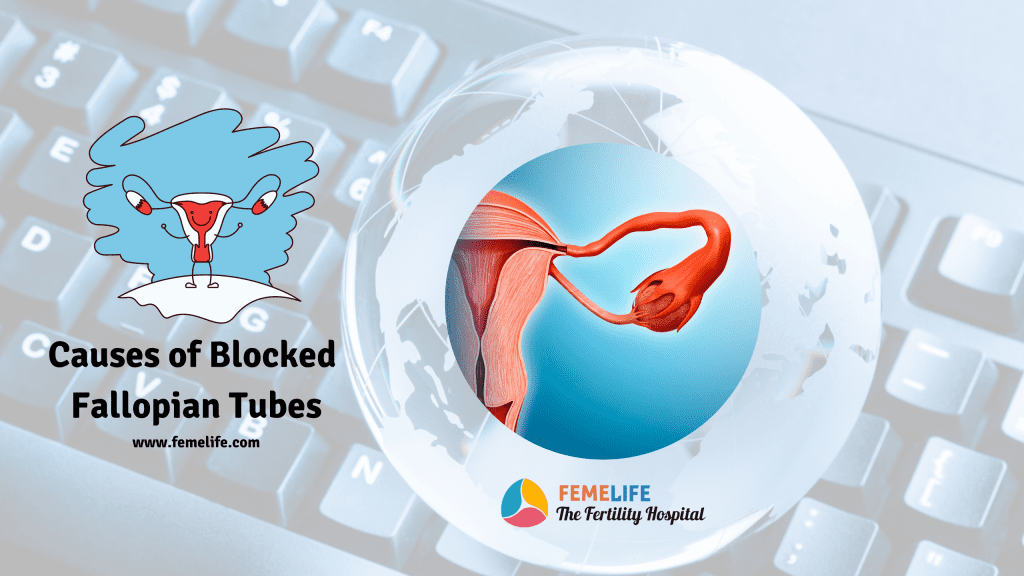Fallopian tubes are female reproductive organs which connects the ovaries and uterus. Every month during ovulation, the tubes carry the egg from ovary to uterus. As a result conception happens in the tubes. After fertilization the embryo moves through the tube to uterus for implantation. If you have blocked tubes, the passage for sperm to get to eggs can not happen. As a result, the path back to uterus for the fertilized egg doesn’t take place.
Symptoms of blocked fallopian tubes
Blocked tubes don’t have symptoms. These women don’t have symptoms until they try to get pregnant and have trouble. In some women infected swollen tubes can cause some mild, regular pain on one side of the abdomen. This blocked fallopian tubes usually happens in a type of blockage called hydrosalpinx. Where the fluid fills and enlarges the reproductive pipes.
Effect on fertility due to tubal blockage
Blockage in the reproductive pathways are a most common cause of infertility. Sperm and egg meet in the fallopian tube for the fertilization. A blocked tube is prevents that fertilization.
Blockage of both tubes prevents natural pregnancy. If your fallopian tubes are partially blocked means that you can potentially get pregnant. But however, the risk of an ectopic pregnancy increases.
Ectopic pregnancy is because it’s harder for a fertilized egg to move through a blocked fallopian tube to the uterus. In these pathways are blocked, your doctor might recommend for in vitro fertilization (IVF), depending on treatment is possible.
One sided blockage of tubes mostly won’t affect your fertility. This is because an egg can still travel through the unaffected fallopian tube to uterus. Fertility drugs can help increase the chance of ovulating on the open side.
Causes of blocked fallopian tubes
Mostly the tubes are blocked by scar tissue or pelvic adhesions. Blocked fallopian tubes can be caused by many factors, including:
• Pelvic inflammatory disease: Pelvic inflammatory disease can cause scarring or hydrosalpinx.
• Endometriosis: Endometrial tissue can build up in the fallopian tubes and cause a blockage in the tubes. Endometrial tissue on the outside of other organs can also cause adhesions that may block the fallopian tubes.
• Certain sexually transmitted infections (stis). Chlamydia and gonorrhea can cause scarring and lead to pelvic inflammatory disease which blocks the fallopian tubes.
• Past ectopic pregnancy. This can scar the fallopian tubes and block it.
• Fibroids. These fibroids growths may block the fallopian tubes, particularly where they attach to the uterus.
• Past abdominal surgery. Past surgery, especially on the fallopian tubes themselves, can lead to pelvic adhesions that block the fallopian tubes.
You can not prevent many of these causes but can go for alternative treatment.
Diagnosing a blocked fallopian tube
Hysterosalpingography (HSG) is a type of X-ray used to examine the inside of fallopian tubes to help diagnose the blockages and where this block is present. During HSG, your doctor introduces a dye into your uterus and fallopian tubes through cervix.
This dye helps your doctor to see more of the inside of your fallopian tubes on the X-ray. An HSG can usually be done in hospitals. It should take place within the first half of your menstrual cycle between 14-18 days of periods. In this procedure Side effects are rare, but may have false positive results are possible.
If the HSG doesn’t help your doctor make a definitive diagnosis, they can use laparoscopy for further evaluation of blocked fallopian tubes. Benefits of this laparoscopy is if the doctor finds a blockage during the procedure, they might remove it, if possible.
Treating tubal factor infertility
If your fallopian tubes are blocked by small amounts of scar tissue or adhesions, your doctor can use laparoscopic surgery to remove the blockage and open the tubes where the eggs can travel to the uterus or sperms can travel through the fallopian tubes.
If your tubes are blocked by large amounts of scar tissue or adhesions means in this stage the treatment to remove the blockages may not be possible.
Other treatments are Surgery to repair tubes damaged by ectopic pregnancy or infection may be an option. If a blockage is caused because part of the fallopian tube is damaged, where a surgeon can remove the damaged part or blocked part and connect the two healthy parts.
The possibility of pregnancy after tube blockage
It’ is possible to get pregnant following treatment to clear the reproductive passages. Your chances for pregnancy will depend on the treatment method and severity of the blockage of tube.
A successful pregnancy is more possible when the blockage is near the uterus. Success rates are little less if the blockage is at the end of the fallopian tube near the ovary.
The chance of getting pregnant after surgery for tubes damaged by an infection or ectopic pregnancy is less only where it depends on how much of the tube must be removed and what part is removed.
Consultant your doctor before treatment to understand your chances for a successful pregnancy.
Complications of blocked tubes
The most common complication of blocked fallopian tubes is ectopic pregnancy. If a tube is partially blocked, an egg may be able to be fertilized, but there may get stuck in the fallopian tube. Where the embryos develop growth inside the tubes. This results in an ectopic pregnancy, which is a medical emergency.
Surgery that removes part of the fallopian tube also may increases the risk of ectopic pregnancy. Because of these risks, doctors often recommend IVF treatment instead of surgery for women with blocked tubes who are otherwise healthy.

